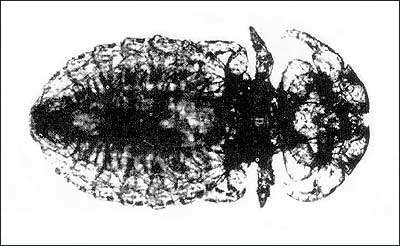Parasites and Diseases
Lice
A Field Guide
TO COMMON WILDLIFE DISEASES
AND PARASITES IN ALASKA
LICE

Trichodectes canis louse from a wolf.
| What causes lice? |
- Lice are small wingless insects that are spread by direct contact between animals.
- There are two kinds of lice, biting lice and sucking lice.
| Where are lice found? |
- There are many types of lice that are found on many different animals.
- Lice are very host specific and don’t move from one type of animal to another.
- The dog louse, Trichodectes canis, is found on wolves from the Kenai Peninsula and also northwest of Palmer. It currently has been found on wolves from the Kenai Peninsula, the Mat-Su Valley around Palmer and Glenallen, and portions of the Interior. Different species of lice are also occasionally found on ducks and grizzly bears throughout the state.
| What are the signs of lice? |
- Lice are small (1/16 to 1/4 inch), flat, wingless insects with bodies divided into three distinct sections.
- Lice attach their very small eggs to the hairs of their host.
- Biting lice cause mild hair matting or loss.
- Sucking lice pierce the skin and suck blood.
- Large numbers of lice may cause weakness from blood loss (and possibly death in young or sick animals).
- Sucking lice can also cause allergic reactions.
| How can I protect myself? |
- You cannot get lice from infected animals.
- Lice may reduce the value of the animal pelt.
| Can I eat the meat? |
- Meat from affected animals is suitable for human consumption.
| Samples to collect |
- Whole lice
- To report an occurrence or to submit a sample for identification/analysis, contact the DWC Wildlife Disease Surveillance reporting hotline 907-328-8354, send an email to dfg.dwc.vet@alaska.gov or visit your local ADF&G office.
